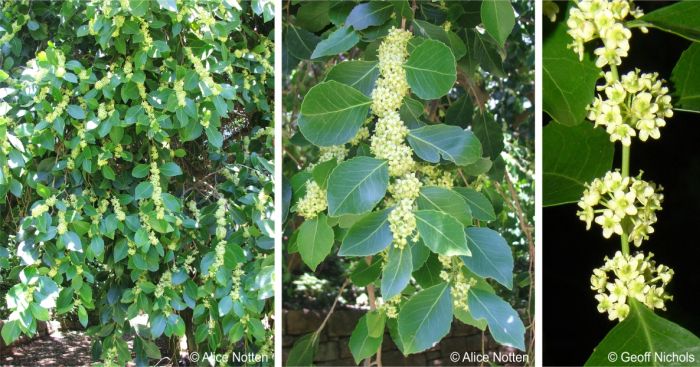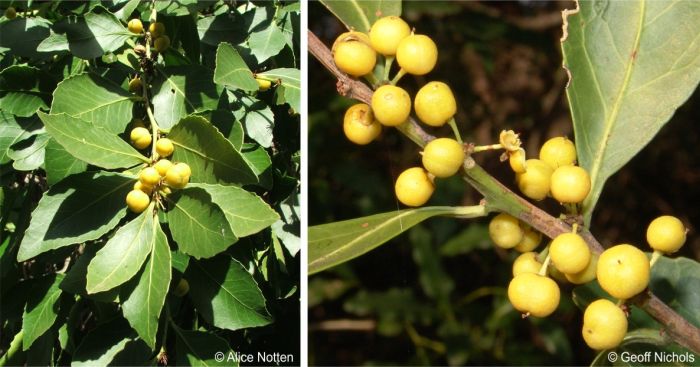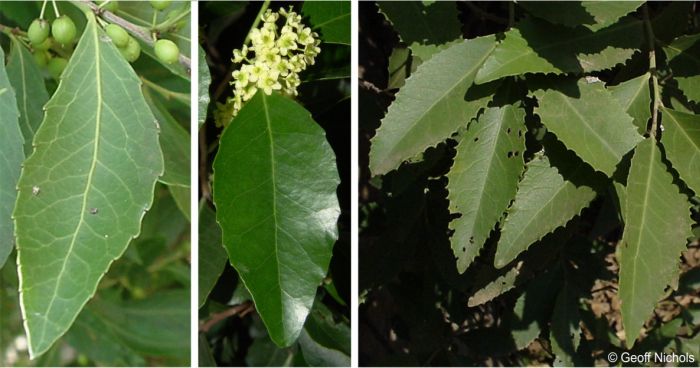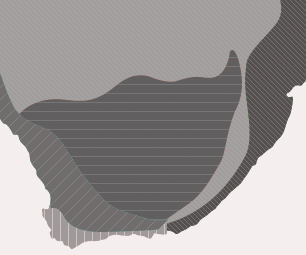Maytenus undata
Maytenus undata (Thunb.) Blakelock
Family: Celastraceae
Common names: koko tree (Eng.); kokoboom (Afr.); umkokane, umnqayimpofu, umgora, inqayi-elibomvu (isiXhosa); idohame, inqayi-elibomvu, igqwabali, ikhukhuze (isiZulu); mokokono, morokgwa (Sepedi)
SA Tree No: 403
Introduction
A bushy shrub or small tree with a rounded crown, glossy leaves, unarmed branches, sweet-smelling flowers in summer and yellow to reddish-brown fruits that attract birds. Easy to grow from seeds and cuttings. Slow growing, drought tolerant, a good garden subject.

Description
Description
A multi-stemmed shrub 2–3 m tall or single-stemmed, well-branched tree, 6–10 m tall, evergreen, with a rounded crown. Bark smooth, greyish-brown becoming finely fissured and flaky with age. Branches without spines. New growth angular. Leaves alternate, variable, ovate to almost circular, apex broadly tapering to rounded, thinly leathery, glossy dark green to grey-green, duller below, on short stalks. The leaf margins with widely spaced teeth and each tooth is tipped with a small, hard gland. Flowers small pale yellow to greenish yellow, sweet-smelling, in small, dense clusters, 10 x 10 mm, in the axils of the leaves, in summer (November to January). Fruit a yellow to red-brown 3-lobed capsule, 5–7 mm in diameter, splitting to release seeds covered with a shiny, soft, yellow to reddish-brown, aril, in autumn and winter (March to September).

Conservation Status
Status
According to the Red List of South African Plants, Maytenus undata is assessed as Least Concern (LC.). It is not threatened.
Distribution and habitat
Distribution description
Often in rocky terrain, in bushveld, forest, forest margin, ravine forest, open woodland, coastal bush and karoo, from the coast to 1 500 m, in the Eastern Cape, Northern Cape, Free State, Gauteng, KwaZulu-Natal, Mpumalanga, Limpopo, North West provinces of South Africa, and in Lesotho, Eswatini, Botswana and northwards into tropical Africa and in Madagascar and Comoros.

Derivation of name and historical aspects
History
The genus name Maytenus is derived from maiten, mayten or mayton, a Chilean (Araucan) name for the type species Maytenus boaria. The species name undata means ‘wavy edged’ or ‘undulate’ from the Latin unda, meaning ‘a wave,’ perhaps referring to the widely spaced teeth giving the leaf margin a wavy edge.

Ecology
Ecology
The flowers are visited by bees and other insects. Seeds are eaten by birds, which are attracted by the fleshy aril and disperse the seeds in their droppings.

Uses
Use
Wood is reddish, hard, heavy and fine-grained, used in wagon construction and to make farm tools, axe handles, domestic and household items, in hut building, and for firewood. It is also used for fighting sticks.
The bark and root is used in traditional medicine, as a tonic and to treat stomach troubles, fever, coughs, colds and chest complaints, and kidney troubles.
Leaves are used for fodder in times of drought.

Growing Maytenus undata
Grow
Easy to grow from seeds or cuttings, it is an adaptable, frost hardy plant and makes a rewarding garden subject, in sun or semi-shade in well-drained, loamy soils. Ideal for wildlife-friendly and water-wise gardens and a good informal hedge or screening plant. Also suitable for containers.
Collect fresh seeds as the capsules split open and wash off the aril. Sow them in a well-drained seedling mix, in summer. Treat the seeds with pre-emergence fungicide to combat damping off. Place the trays in a warm, well-ventilated, well-lit place, and keep moist but not wet. Transplant the seedlings into individual pots when they are large enough to handle.
Take semi-hardwood heel or tip cuttings from healthy growth, in summer. Treat with a suitable rooting hormone and plant in a well-drained, well-aerated rooting medium and place in a heated mist unit until rooted.
References
- Boon, R. 2010. Pooley's trees of eastern South Africa, a complete guide. Flora & Fauna Publications Trust, Durban.
- Burkill, H.M. 1985. The useful plants of west tropical Africa. Vol. 1. Royal Botanic Gardens, Kew.
- Charters, M.L. 2005–2016. California plant names: Latin and Greek meanings and derivations. A dictionary of botanical and biographical etymology. http://www.calflora.net/botanicalnames/pageV.html accessed 7 Nov 2016
- Coates Palgrave, K. 1983. Trees of southern Africa. Struik, Cape Town.
- Hitchcock, A. 2004. Maytenus acuminata (L.f.) Loes. var. acuminata 'Silky Showers' (Celastraceae). PlantZAfrica. Online. https://pza.sanbi.org/maytenus-acuminata-var-acuminata-silky-showers.
- Manning, J. & Goldblatt, P. 2012. Plants of the Greater Cape Floristic Region 1: the Core Cape Flora. Strelitzia 29. South African National Biodiversity Institute, Pretoria.
- Powrie, F. (ed) 1998. Grow South African Plants. A gardener's companion to indigenous plants. National Botanical Institute, Cape Town.
- Raimondo, D., Von Staden, L., Foden, W., Victor, J.E., Helme, N.A., Turner, R.C., Kamundi, D.A. & Manyama, P.A. (eds) 2009. Red list of South African plants. Strelitzia 25. South African National Biodiversity Institute, Pretoria.
Credits
Alice Notten
Kirstenbosch National Botanical Garden
June 2025
Acknowledgements: additional images by Geoff Nichols
Plant Attributes:
Plant Type: Shrub, Tree
SA Distribution: Eastern Cape, Free State, Gauteng, KwaZulu-Natal, Limpopo, Mpumalanga, North West, Northern Cape
Soil type: Loam
Flowering season: Early Summer
PH: Acid, Neutral
Flower colour: Cream, Yellow
Aspect: Full Sun, Morning Sun (Semi Shade), Afternoon Sun (Semi Shade)
Gardening skill: Easy
Special Features:
Horticultural zones











Rate this article
Article well written and informative
Rate this plant
Is this an interesting plant?
Login to add your Comment
Back to topNot registered yet? Click here to register.